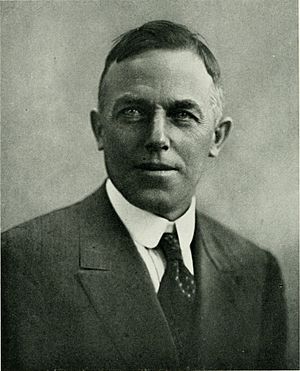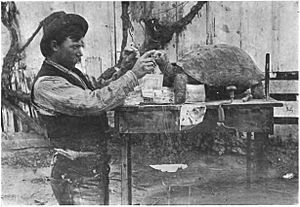Rollo Beck facts for kids
Quick facts for kids
Rollo Howard Beck
|
|
|---|---|

c1900-1918
|
|
| Born | August 26,1870 |
| Died | 22 November 1950 (aged 80) |
| Known for | Catalog of Regional Biodiversity |
| Scientific career | |
| Fields | Ornithology |
Rollo Howard Beck (born August 26, 1870 – died November 22, 1950) was an American ornithologist. This means he was a scientist who studied birds. He was also a famous bird collector for museums and an explorer.
Some animals are named after him. These include a type of seabird called Beck's petrel. Also, three kinds of reptiles are named for him. One is a subspecies of Galápagos tortoise from Volcán Wolf. Experts like Robert Cushman Murphy and Frank Pitelka thought Rollo Beck was an amazing field worker. They said he was the best at studying animals in their natural homes.
Contents
Rollo Beck's Early Life
Rollo Howard Beck was born in Los Gatos, California. He grew up in Berryessa, where he worked on fruit farms. He only went to school until the 8th grade. But he loved natural history from a young age. He would trap small animals called gophers on farms after school.
One of his neighbors, Frank H. Holmes, knew a bird expert named Theodore Sherman Palmer. Palmer helped Beck meet Charles Keeler, who studied birds in the San Francisco Bay Area. Beck learned a lot about birds by hunting quail with Holmes. His interest in birds grew, and he soon learned how to prepare birds for museum collections.
In 1894, he joined the American Ornithologists' Union. He was also one of the first members of the Cooper Ornithological Society in San Jose, California. He went on early trips to the Sierra Nevada Mountains and Yosemite. On these trips, he helped find the first eggs and nests of birds like the western evening grosbeak.
Amazing Expeditions

Rollo Beck went on many important trips to collect birds and other animals. These trips helped scientists learn a lot about nature.
Exploring California's Channel Islands
In 1897, Beck went to Santa Barbara, California. There, he learned how to sail a ship. He visited the Channel Islands of California, like Santa Cruz Island and Santa Rosa. On these islands, he collected birds and their nests and eggs. He was the first to notice that the island scrub-jays on these islands were different from those on the mainland.
First Trip to the Galápagos Islands
Later in 1897, Beck was asked to join a bird trip to the Galápagos Islands. These islands are off the coast of Ecuador. Lord Rothschild paid for this trip. The goal was to study and collect giant tortoises and land birds. Beck improved his sailing skills there. He also learned a lot about seabirds and the unique animals of the Galápagos.
Around 1901, Beck went back to the Galápagos to collect more specimens. He personally took these specimens to Walter Rothschild in England. While there, he planned future trips to Colombia.
The "Academy" Expedition (1905-1906)
In San Francisco, Beck met Leverett Mills Loomis, who led the California Academy of Sciences. Loomis hired Beck to lead a big sea trip to Cocos Island and the Galápagos Islands. They sailed on a ship called the “Academy.” This trip included many scientists. There were experts in plants, reptiles, insects, shells, rocks, and birds.
Together, they collected the largest number of scientific specimens ever from the Galápagos. This helped us understand the animals and plants of the islands much better.
While Beck and the team were still in the Galápagos, the big 1906 San Francisco earthquake happened. The earthquake and fires destroyed San Francisco. They returned on Thanksgiving Day, November 29, 1906. Their huge collection of about 78,000 specimens helped the Academy rebuild. The schooner “Academy” even became the meeting and storage place for the Academy for months. Many historians believe that without Beck's trip, the Academy might not have survived.
In 1907, Rollo married Ida Menzies in Hawaii. She became his lifelong partner. He then worked for Joseph Grinnell at the University of California, Berkeley. He collected waterbirds for Grinnell's studies. Later, he collected birds in Alaska for another famous bird expert, Arthur Cleveland Bent. He worked with a young scientist named Alexander Wetmore on these trips.
South American Adventure (Brewster-Sanford Expedition)
In 1912, a scientist named Dr. Leonard Cutler Sanford suggested a big trip to South America. It was paid for by Mr. F. F. Brewster. Rollo and Ida went on this trip, which lasted five years! They traveled through the Andes mountains, along the coast, and out to sea. They visited the Falkland Islands and Juan Fernández Islands. They even sailed around Cape Horn in a small boat. The birds they collected were very important for a book called “The Oceanic Birds of South America.”
The Whitney South Seas Expedition
In 1920, Dr. Sanford asked Beck to join a very long trip to the South Pacific. This trip was paid for by Harry Payne Whitney. The specimens they collected went to the American Museum of Natural History. This was Rollo Beck's longest and biggest expedition. Many other skilled biologists joined him.
Beck left the trip in 1929. He had sailed all over the Pacific, from Tahiti to New Guinea and New Zealand. He visited hundreds of islands. Rollo and Ida Beck returned to California in 1929 with over 40,000 bird skins. They also had a large collection of items related to human cultures. This expedition is still the most complete study of birds in the southwest Pacific islands.
Rollo and Ida Beck retired to Planada, California. They kept studying nature and collecting valuable specimens. Many of these later specimens are at the California Academy of Sciences. Others are at the Museum of Vertebrate Zoology at the University of California, Berkeley. There is also a special exhibit about Rollo Beck at the Pacific Grove Museum of Natural History.
Why Rollo Beck's Work Matters
Rollo Beck and other early bird experts worked to record all the different kinds of life on Earth. They wanted to understand how animals change over time and how they live in their environments. Their work created a list of all the animals and plants in different areas. This list is very important for protecting nature today.
Much of what we know about birds in the western U.S. and the Pacific comes from Rollo Beck's work. His collections helped scientists write important books about birds. Modern efforts to protect animals owe a lot to these early collectors. They worked hard to document and save specimens in museums.
Reptiles Named After Beck
Three types of reptiles have scientific names that honor Rollo Beck:
- Chelonoidis nigra becki, a type of tortoise
- Sceloporus occidentalis becki, a type of lizard
- Sphaerodactylus becki, another type of lizard
See also
 In Spanish: Rollo Beck para niños
In Spanish: Rollo Beck para niños

